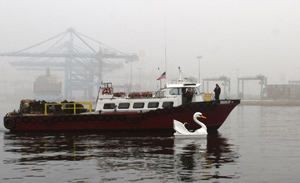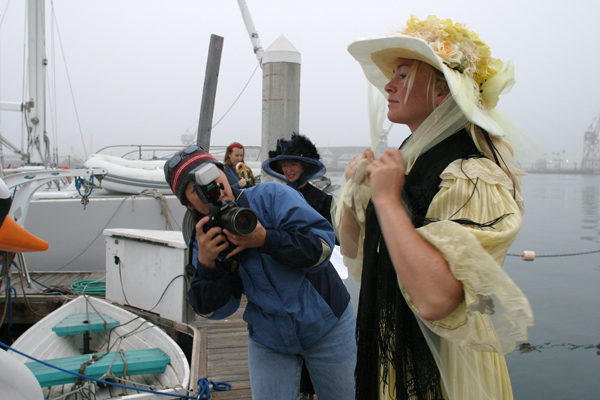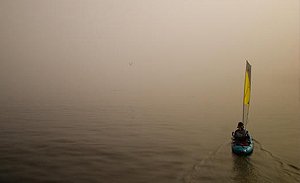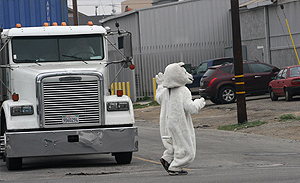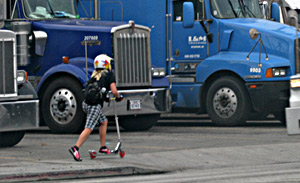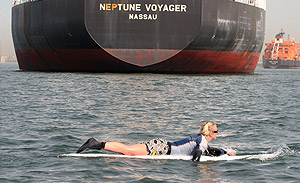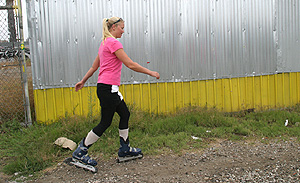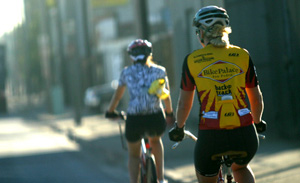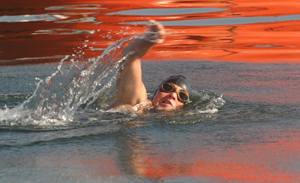|
Supercommute 8: Victorian Swan Pedal
After I dropped my mom off at the airport, I took the swan, Hattie May, back to her home at Mountain Lake Resort on Tuesday. She seemed to be at peace in the calm small lake after her great sea adventure, but I'm sure she won't forget the time she swam with the cargo ships and oil tankers. The weather was perfect and it really was just a nice stroll in the port, not unlike the summer conditions on the lakes in Boston where Hattie May was invented over a hundred years ago. Of course she wasn't being used for transportation, but for leisurely afternoon rides. Three beautiful ladies in the port seemed appropriate for the finale commute, because after all, a good ship is a woman and a bad ship is uhh . . . sunk. I managed to survive Supercommute without sinking, drowning, or getting demolished by a semi. Now the challenge is the exhibition display, but I'm sure I'll have that figured out by April.
Supercommute 7: Hobie Sail
I watched the cargo ships and imaged them sailing instead. I think it would be possible since that’s how we used to move stuff around the world, but I think it might be more efficient to just make our own stuff here. At this point we would need too many sails because we import so much stuff and it might be easier to just grow food in our yards and sew our own clothes. Sailing takes a long time and I'll confess that I didn't actually rely on Monday's wind. It would have taken me all day and since the Long Beach Windsurf Center supplied the Hobie craft with foot pedals, I decided to use them. The foot pedals work much better than the typical pedal boat, because they are designed after penguins. Next weeks Supercommute may take a little longer, but it should be fun.
Supercommute 6: Polar Bear Run
Yet when I thought about it, there's really nothing happy about a sweaty running polar bear. As the main icon for global warming, polar bears are drowning to extinction and most likely would not end up searching for a life in Wilmington. But as with any species, including humans, loss of habitat often leads to either extinction or a migration to the city. In this case, a lone Supercommuting polar bear somehow washed up on the shores in the Port of Los Angeles and had no alternative but to start running. And then drink a Coke.
Supercommute 5: Extreme Razor Scooter
After scootering 16 miles through the industrial ghetto of Wilmington, I have decided that I am the latest example of an extreme athlete. Dodging18-wheelers moving toward me in all directions required fierce focus and commitment if I was going to make it from one extreme to the other. Semi-trucks, SUVs, inconsistent pavement, and unpredictable curbs replaced the typical avalanche or 60ft wave. But I made it alive, and now I am going to razor everywhere because the adrenaline is unmatched. I recommend razor scootering to work for any adrenaline junkie. Razor scooters rule!! And they' re relatively cheap.
Supercommute 4: Paddle
The port had an uneasy quietness and it seemed as though the only activity in the harbor was by my side. Yet, I was amazed by the generous amount of support I had beginning with Byron Design Surfboards. With last minute notice, Byron Olson shaped a custom 9ft longboard for Supercommute in support of the environmental purposes of the project. The port authorities also showed support by sending out an escort boat for a paddle that would grant some large fines under typical circumstances. My support boat, the Blackjack housed captain Herman driving, Louie Carasco (who learned to use my camera five minutes before we left), and Diandra from the Press Telegram who has a tendency toward seasickness. Jocelyn Foye paddled a kayak next to me, distracting me from shoulder and back pain, as she told stories throughout the whole journey. When we arrived at the Alamitos Bay entrance, I saw a couple waves break inside the harbor and it was my dream to surf one as part of the commute. Unfortunately, I couldn't paddle into a wave due to a complete lack of strength. It took me most of the week to recover from the paddle with fatigue, a cough, shoulder and back pain, and some stomach issues most likely as a result of ingesting port water.
Supercommute 3: Rollerblade
This summer my truck was broken into while I was traveling to Colorado. The truck was striped to its shell so that every minute item was stolen including the ashtray, glove box, swim cap and goggles, and even my coffee mug. Yet, my rollerblades remained. I can only conclude this was due to the fact that rollerblading has gone utterly out of style. The anomaly of rollerblading as a form of transportation or even recreation was reinforced by the confused stares by motorists and any other spectators along Monday's rollerblade commuting route. Two weeks ago my catalytic converter and muffler were stolen from under my truck. Today when I went to fill up my gas tank and gasoline spilled on the concrete rather than filling the tank, I realized that sometime in the last few days fuel had been siphoned out of my truck by cutting a large slit though the rubber hose leading to the fuel tank. My truck, the Giving Tree, has nothing left. It strikes me as if I was rollerblading to class while someone was simultaneously siphoning my gas. Is it coincidental that my truck is becoming less and less drivable just as I am trying not to use it? The fuel crisis is apparent and I look forward to the day I can rollerblade from A to B safely without a support vehicle.
Supercommute 2: Bike
However, the bike commute did present us with some dangers. It became apparent that the road was not designed for bicycle use when Christen fell crossing a set of train tracks that sit at a slight angle to the road. Brad House, from Back on Track Productions and San Pedro's Bike Palace, said that the tracks had caused many cycling accidents. Kyle said that he had almost gotten hit just before tying in with us (wear a helmet next time Kyle!), and to say the least we all inhaled exhaust. I can't wait for next week's rollerblade adventure!
Supercommute 1: Swim
My friend was nearby on an aluminum skiff with his dog and I could hear the props turning as he zoomed around the other boats. As I noticed people lined up on the fuel dock waving their arms, I also became aware that the channel 11 helicopter was still somewhere overhead. "What did I get myself into this time?", I thought. All of these people were here to support me and watch the most boring spectator sport possible, long distance swimming. I started to feel uncomfortable about the attention, but fortunately I couldn't speak, hear, or see clearly, so I reminded myself that I did have a purpose and if people watch Brittany Spears then anything is legit. I felt nervous and under-trained because I had only done eight ocean training swims, all under 6 miles, and I was never a competitive swimmer. Yet I just keep moving my arms considering the fact that many have swum farther. Yesterday's port swim felt like something out of the imagination, a surreal slow-motion navigation through moving cargo ships, anchored oil tankers, and a sense of being a mute spectacle. Although my left shoulder hurt from tendonitis, the continuous diesel fumes throughout the port made me feel sick, and at one point I was fatigued, my greatest challenges were mental. Around mile 9, I noticed a tall building on the coast. Every time I turned my head to the left to breathe I could see that same building. Breath after breath its location did not change. Was the current suddenly against me? I became sure that I was not moving, and through anger and frustration I kicked harder and moved my arms faster. But my swimmers temper tantrum was not getting me anywhere, and I could still see that same building. It was at that point in the swim that I realized that swimming is a slow form of transportation and I must engage in the experience rather than fight it. I had to forget about our faced paced culture for a moment and enjoy the view of the building on Ocean Boulevard. If I could not do this, I wasn't going to finish. This is what it feels like to not drive.
|

